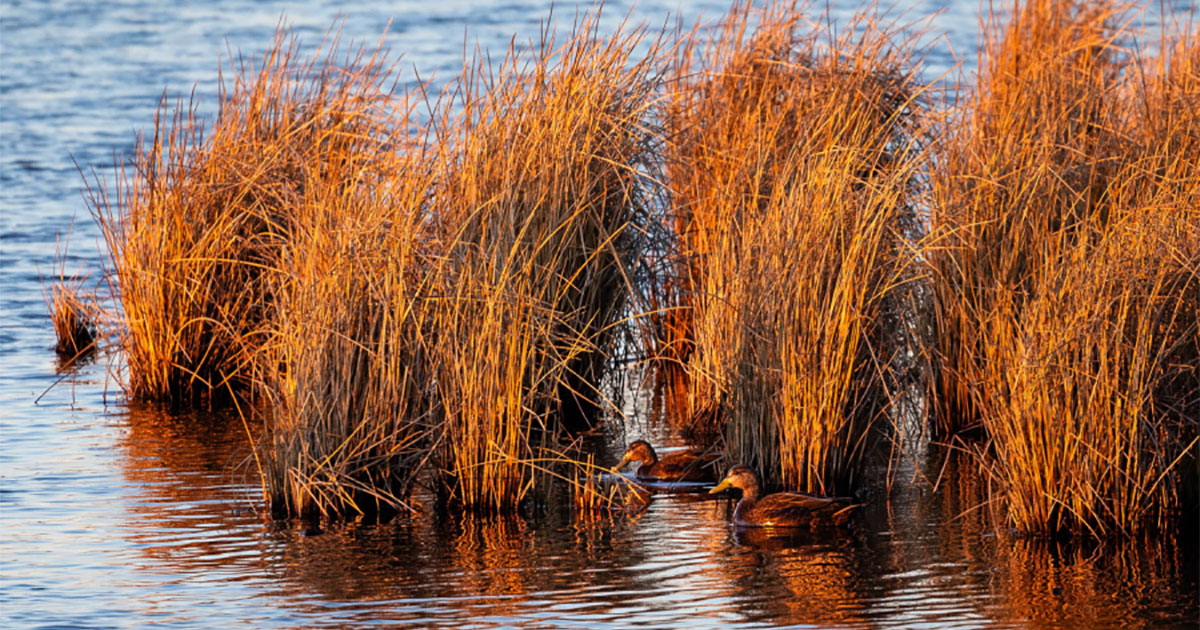Experts from the Chesapeake Bay Program report that between 2014 and 2022, the Chesapeake Bay watershed gained 4,310 acres of newly created or restored wetlands. This is a slight increase (5.1%) of the Chesapeake Bay Watershed Agreement outcome to create or reestablish 85,000 acres of tidal and non-tidal wetlands, primarily on agricultural or natural landscapes. This figure includes 616 acres of wetlands on agricultural lands.
The Watershed Agreement outcome also calls for the function of 150,000 degraded wetlands to be enhanced by 2025. The latest data shows that 60,666 acres of wetlands have been enhanced (i.e., improving one or more functions of an existing wetland) between 2014-2022, meeting 40.4% of this goal.
Previously, the Wetlands Outcome was tracked using data collected through the National Environmental Information Exchange Network (NEIEN). These data were reported by each of the watershed jurisdictions—Delaware, the District of Columbia, Maryland, New York, Pennsylvania, Virginia and West Virginia—as part of their annual Watershed Implementation Plan tracking to the Environmental Protection Agency under the Chesapeake Bay Total Maximum Daily Load. This means that only those wetlands that were created or restored for the purposes of meeting water quality goals were reported. Additionally, NEIEN does not track the acreage of wetlands enhanced, and the process in which these data were collected varied from jurisdiction to jurisdiction.
In 2023, the Wetlands Workgroup released a new tracking system, Habitat Tracker, that allows data for all created, restored and enhanced wetlands to be reported. However, due to this reporting transition, it is likely that all reported gains and enhancements are not yet accounted for, as not all watershed jurisdictions track their data to the degree of resolution required for data standardization. Please note that wetland losses are not yet available through the Habitat Tracker tool.
Despite these data gaps, the Habitat Tracker now provides a streamlined method for watershed jurisdictions to provide wetlands enhancement data, in addition to the acres of wetlands created or reestablished, for both tidal and nontidal wetlands.
Facts
The Chesapeake Bay watershed is home to two broad categories of wetlands—tidal and nontidal. Tidal, or estuarine wetlands, are found along the shores of the Chesapeake Bay and its tidal tributaries. Nontidal wetlands are located along floodplains bordering rivers and streams, along the shorelines of lakes and ponds, or covering flat areas where water may collect. Types of wetlands include marshes, swamps, bogs and even living shorelines.
Issues
Development, sea level rise and invasive species pose major threats to wetlands. Development along beaches and shorelines blocks the creation of further wetland habitat and creates excess sediment. Sea level rise can flood wetlands and marshes with saltwater, destroying plants faster than they can populate to higher ground. Invasive plants and animals can crowd out native species and damage wetland habitat.
Importance
High-quality, abundant wetlands are vital to the health of the Chesapeake Bay. They provide critical habitat for fish, birds, mammals and invertebrates, while supporting recreational fishing and hunting. Wetlands also trap polluted runoff and slow the flow of nitrogen, phosphorus and sediment, as well as toxic contaminants into rivers, streams and the Chesapeake Bay. They also help adapt to climate change impacts by soaking up stormwater and dampening storm surges, while slowing the erosion of shorelines and protecting properties from flooding.
Quotes
“It is promising that the Chesapeake Bay Program is moving in the right direction to increase wetland acreage throughout the watershed. We need to keep a focus on this important work to offset historic losses and anticipated impacts due to development and sea level rise,” said Pam Mason, Chair, Wetlands Workgroup and Professor, Virginia Institute of Marine Science.
“It is inspiring to see the involvement and dedication of the Wetlands Workgroup as we move toward gains in wetland acres across the watershed. Wetlands are a cornerstone of the Chesapeake Bay, offering so many benefits to its wildlife and people. We cannot overlook the restoration of these critical habitats,” said Tess Danielson, Vice-Chair, Wetlands Workgroup and Environmental Protection Specialist, Department of Energy and Environment, District of Columbia.
“Without our wetlands, the residents of the Chesapeake Bay watershed would see a rapid decline in their quality of life. I am looking forward to working with our partners to advance wetland protection despite the many obstacles that stand in the way,” said Nancy Schumm, Vice-Chair, Wetlands Workgroup and Chief, Environmental Services, City of Gaithersburg, Maryland.



